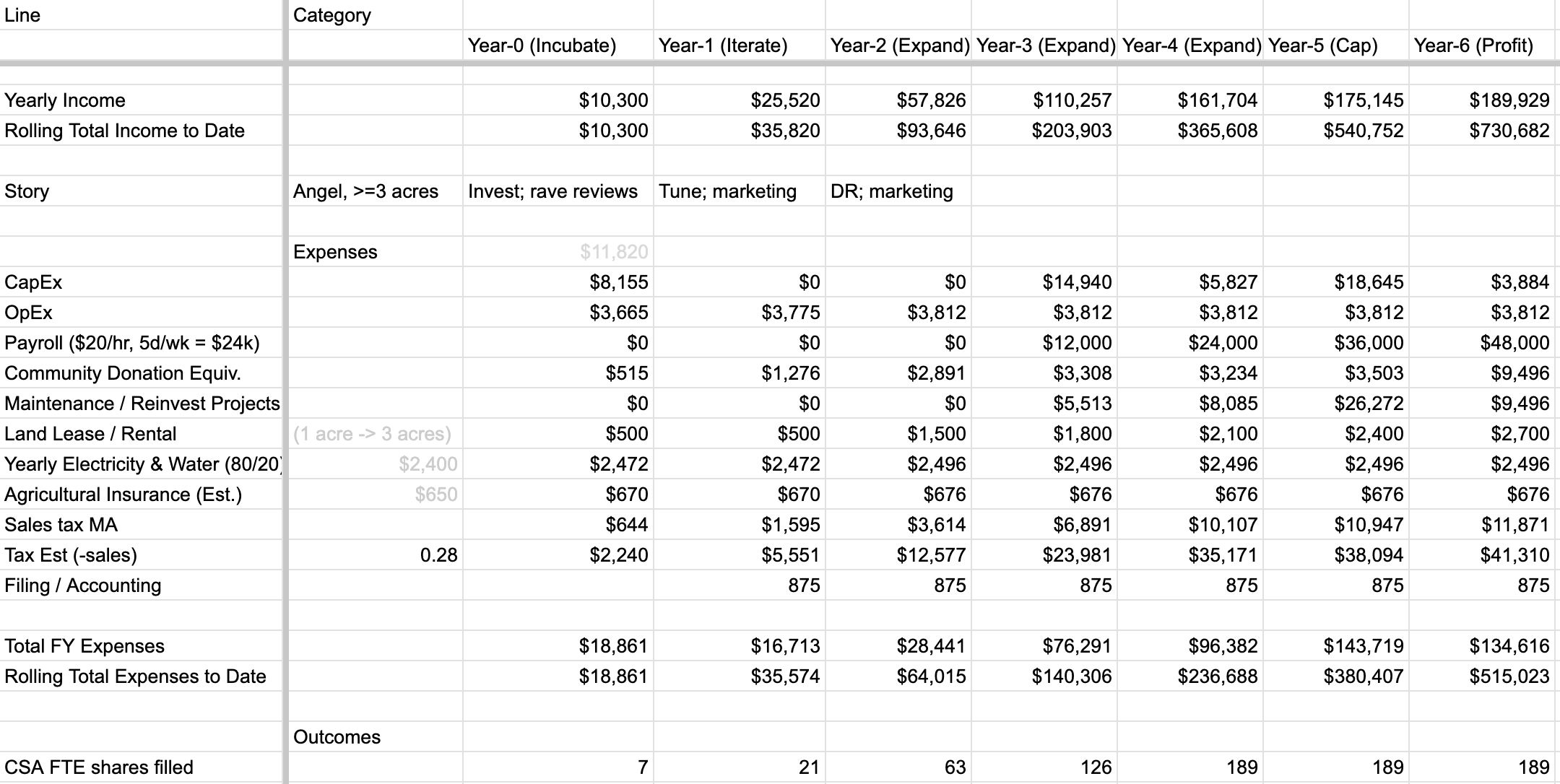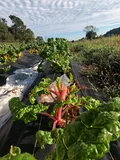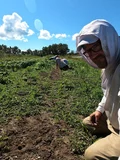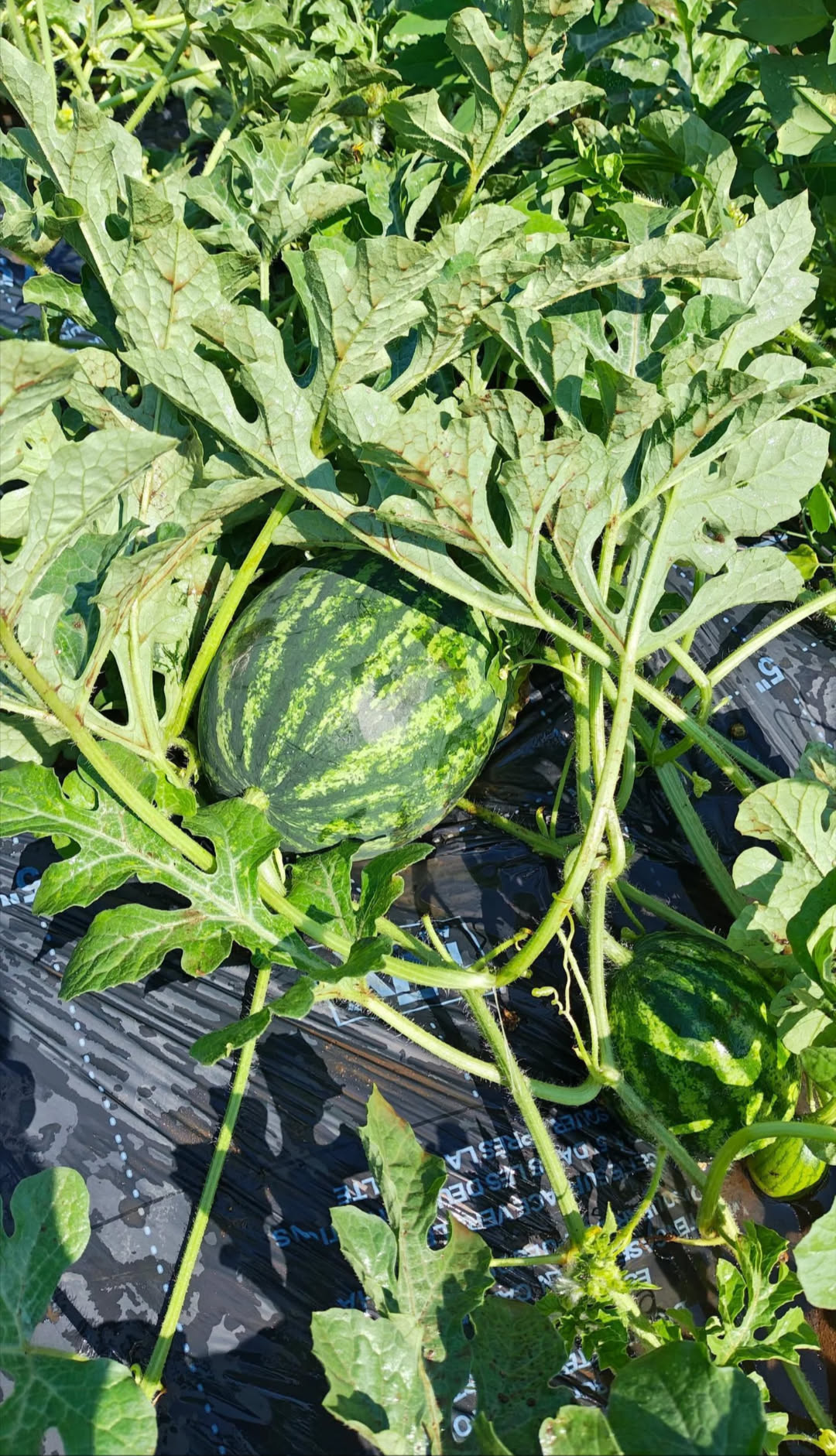TL;DR
Today we harvested swiss chard, cherry and slicer tomatoes, and italian peppers. Then we packed the van and prepared for the market.
I also checksummed assumptions and challenges in my weekend startup farm business modeling while I rode around with Jamie doing chores and projects.
The Very Definition of ‘Not Easy’
I am not a religious or spiritual person but grew up in that way. To each their own…if only that wasn’t also as problematic a worldview. But while I am weeding or digging or collecting salt marsh hay for mulch, I occasionally remember a passage from my upbringing, memorized ‘scripture’, particularly Genesis 3:17-19, “By the sweat of your brow you will eat your food until you return to the ground”.
Farming is very much ‘not easy’. It’s long hours for most of the year. It’s dangerous work if you don’t know how to avoid risks. It’s physically demanding, not because of some curse a big bogey man in the sky put on humans, but because of physics and biology and genetics. Feeding five thousand people doesn’t happen like some goofey magic trick. It’s a challenging process that requires a lot of planning and experience. It takes dedicated humans who are passionate about farming and willing to put in the hard work. And it takes patience, even the simple things like moving chicken coops and irrigation lines.
There’s no such thing as easy on the farm compared to white collar work in an office. Corporate culture is so transient, so shallowly rooted, and so focused on short-term gains and quarterly results that it’s hard to find a sense of purpose or meaning in the work. Farming, on the other hand, is a way of life that requires a deep connection to the land and a commitment to the long-term health and well-being of the community.
Farming a Metaphorical Desert
Strangely, working this farm job is my petulant way of wandering a career desert that is the tech industry in 2025 for both tenured professionals like me and recently minted computer science grad students. It’s disappointing that I, a computer science and business administration double-major and incomplete undergrad, fell into a 25 year hole of time-spend just to make my nut all those years.
The worst part is that I never knew how much a difference a $20,000 cash infusion would make for a local farm producing actually valuable things that feed people. That’s not a small amount of money to most working class, but it’s effectively three or four paychecks for a tech worker. They could invest it in a farm and make a huge difference in the lives of people in their community.
Startup Farm Business Modeling
This past weekend on the ride back from Maine, I had some passenger time to work on a Google spreadsheet to model the business of a startup farm. Just as a hypothesis, I’m not yet sure if this is a viable business model or not, still in the early stages of thinking about this. A few notable themes came out of the exercise:
Economic Viability
- The first two years, even with a $20,000 cash investment, the farm would operate at a loss
- The initial investment would be paid back in the third, fourth, and fifth years
- The first $20k payout to the farm operator would be in the third year, with $10k increases each following year. By year 6, payouts are sufficient for living wage.
- The first three years are pretty brutal on the farm operator(s) which is why many small farms start with two people (usually a homesteader couple). By year 3, another pair of hands must be added for backup and away support (chickens, etc).
- There are most certainly other models that don’t include or specialize in a CSA, restaurants, cut flowers, and value-added products; this one includes a bit of each
Minimum-viable Resources
- A nursery greenhouse for seedlings is a must for “year 0”
- A refrigerator is table stakes for year 1 and 2 of CSA production
- Water for minimal irrigation during dry spells is essential
- Electricity for the fridge and miscellaneous other equipment is needed
Minimum-viable Sellable Products
- Eggs, as it turns out, keep the farm from going under in the first two years
- CSA vs. restaurants vs. direct-to-consumer is not an either/or decision but a as-much-as-possible at first until the farm’s presence in the community is established
- Cut flowers and value added products improve the early year’s bottom line
- I have a few ideas for ‘value added’ products like jams, pickles, honey, dehydrated veg chips which can also be sold given the right regulatory compliance

Other Business Models
Of course there are many other business models that could be explored, such as a farm-to-table restaurant, a community garden, or strictly value-added product manufacturing and distribution. And I have to run simulations on many other models to see which one is the most viable for me. I don’t like the idea of being burned out within the first three years, so that’s the first thing I want to address. Then it will be a matter of finding the right balance between the different models to create a sustainable and profitable farm.
There are also many programs in the Massachusetts area, notably New Entry Sustainable Farm Project in Beverly, offering resources and support for new farmers. I volunteered there last year and learned a lot about their programs and resources such as greenhouse and fridge space, large equipment operation, and training. I definitely want to take their pre-requisite courses once the season winds down.
Continue to Capture and Improve
The work I’m doing in the field and on this blog, to some, are diametrically opposed efforts. During the day on the farm I punish my body and feed my mind. After the farm I punish my brain and feed my body. I’m constantly adding ‘better options’ to my queue of future work in preparation for the farming ‘off season’…tech, logistical, and strategic solutions for various challenges I encounter daily.
Despite the limited time, I still have ideas for how to improve the use of LLMs and machine learning in agriculture. “I’m also considering how to use AI to optimize crop yields and reduce waste” is what AI auto-complete wants me to say, but in reality there are far greater problems like agricultural labor shortages and the lack of access to capital for small farmers to attack head on.
Today’s summary is a point sample to various thematic challenges and potential improvement areas, many of which are already in motion for next year. Hopefully over the winter I can harvest (no pun intended) some of the important but easy to skip over issues that will help me make a more informed decision about the future of this farm.
For today, the auto-summary of field notes is below:
AI Summary from Field Notes
Consolidated Summary
Main Themes
- End of Season Crop Management: Harvesting Swiss chard and preparing for the next growing season.
- Irrigation Maintenance: Addressing issues with the irrigation system (e.g., clogged pump, shallow pond intake).
- Farm Logistics: Packing the van, coordinating market setup, and managing animal care.
- Crop Care: Weeding carrots, harvesting tomatoes, and managing plant health in low-light conditions.
- Seasonal Challenges: Reduced sunlight affecting crop growth and timing for market readiness.
Activities Performed
- Harvested Swiss chard (25 bunches).
- Collaborated with Jamie to fix irrigation lines and address sprinkler issues.
- Harvested cherry tomatoes (not in the hoop house).
- Weeded carrots to reduce weed competition.
- Packed the van and prepared for market pickup.
- Attended a meeting to coordinate market setup.
- Washed peppers and watered pigs and chickens.
- Purchased feed for animals.
New Observations/Discoveries
- Shallow Pond Intake: The pond’s shallow area causes irrigation clogging.
- Weed Competition: “Purge lane” weeds outcompete carrots, requiring strategic weeding.
- Market Coordination: The farm needs better planning for market logistics.
Questions for Future Research
- Can remaining Swiss chard be harvested again?
- How effective is weeding for carrot growth, and how long does it take?
- How to optimize irrigation to prevent clogging in the shallow pond area?
- How does reduced sunlight affect crop regeneration, and what strategies can mitigate this?
- How to improve coordination for market setup and delivery?
Suggestions for Action
- Monitor Swiss Chard: Track remaining chard to determine final harvest feasibility.
- Optimize Irrigation: Investigate deeper pond areas or alternative intake locations.
- Strategic Weeding: Prioritize weeding carrot patches to ensure plant dominance.
- Document Market Coordination: Create a checklist for efficient market setup.
- Experiment with Crop Timing: Test planting dates and irrigation schedules to adapt to seasonal changes.
This summary integrates key findings, actions, and future considerations from the field notes.
Part 1
Main Themes:
- End of Season Crop Management: Harvesting Swiss chard, which is nearing the end of its growing season, and preparing for the next season.
- Irrigation Maintenance: Addressing issues with the irrigation system (e.g., clogged pump, shallow pond intake).
- Farm Logistics: Preparing for market pickup, packing the van, and coordinating with the team.
- Crop Care: Weeding carrots to support their growth and managing tomato harvesting.
- Seasonal Challenges: The impact of reduced sunlight on plant health and the need for timing in crop management.
Activities Performed by the Intern:
- Harvested Swiss chard (25 bunches) at the end of the season.
- Collaborated with Jamie to move irrigation lines and fix the sprinkler system.
- Harvested cherry tomatoes (not in the hoop house).
- Weeded a patch of carrots to help them compete with weeds.
- Helped pack the van and prepare for market pickup.
- Attended a meeting to coordinate market setup.
- Washed peppers and watered pigs and chickens.
- Purchased feed for the chickens and pigs.
New Things Not Yet Encountered:
- Pond Intake System: The irrigation system’s intake hose is located in a shallow part of the pond, which can lead to clogging.
- Weed Competition: The “purge lane” (a term for non-edible weeds) is outcompeting carrots, requiring manual weeding.
- Market Setup Coordination: The intern mentions a meeting to accelerate the setup for the general store, suggesting logistical planning for market days.
Questions and Future Research Areas:
- Swiss Chard Harvesting: Will the remaining chard be harvested again, or is it too late?
- Weeding Effectiveness: How much time is needed to fully weed the carrot patch, and is it sufficient for their growth?
- Irrigation System Reliability: How can the shallow pond intake be optimized to prevent clogging?
- Seasonal Timing: How does reduced sunlight affect crop regeneration, and what strategies can be used to mitigate this?
- Market Logistics: How can the farm better coordinate with the market setup to ensure timely delivery?
Suggestions for Action:
- Monitor Swiss Chard: Keep track of the remaining chard to determine if a final harvest is feasible.
- Optimize Irrigation: Investigate deeper pond areas or alternative intake locations to prevent clogging.
- Weed Carrots Strategically: Prioritize weeding the carrot patch to ensure they dominate the space.
- Document Market Coordination: Create a checklist or schedule for market setup to improve efficiency.
- Experiment with Crop Timing: Test crop management strategies (e.g., planting dates, irrigation schedules) to adapt to seasonal changes.
[end of post]
Enjoy Reading This Article?
Here are some more articles you might like to read next:













